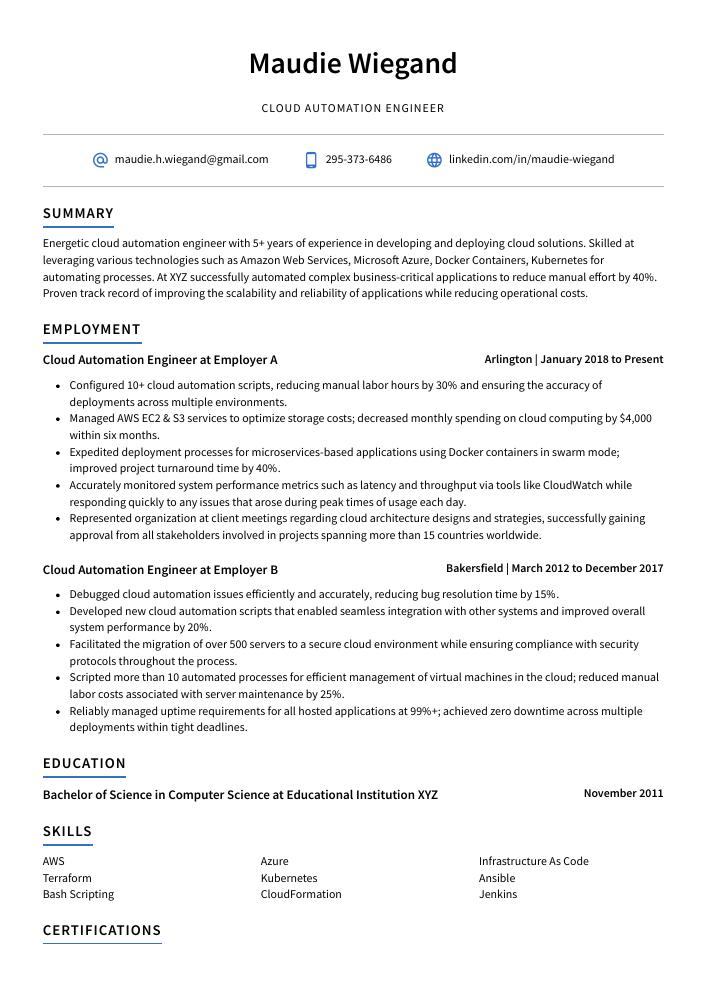Cloud Automation Engineer Resume Guide
Cloud automation engineers design, develop and maintain automated cloud-based solutions to optimize performance and reduce costs. They create scripts that automate various processes within the cloud environment, monitor system performance, troubleshoot issues, deploy applications and manage resources in a cost-effective manner.
You have the expertise and know-how to make cloud automation a reality, but no one knows who you are. To get noticed by potential employers, writing an informative resume is essential. Let your knowledge of cloud engineering shine in your application!
This guide will walk you through the entire process of creating a top-notch resume. We first show you a complete example and then break down what each resume section should look like.
Table of Contents
The guide is divided into sections for your convenience. You can read it from beginning to end or use the table of contents below to jump to a specific part.
Cloud Automation Engineer Resume Sample
Maudie Wiegand
Cloud Automation Engineer
[email protected]
295-373-6486
linkedin.com/in/maudie-wiegand
Summary
Energetic cloud automation engineer with 5+ years of experience in developing and deploying cloud solutions. Skilled at leveraging various technologies such as Amazon Web Services, Microsoft Azure, Docker Containers, Kubernetes for automating processes. At XYZ successfully automated complex business-critical applications to reduce manual effort by 40%. Proven track record of improving the scalability and reliability of applications while reducing operational costs.
Experience
Cloud Automation Engineer, Employer A
Arlington, Jan 2018 – Present
- Configured 10+ cloud automation scripts, reducing manual labor hours by 30% and ensuring the accuracy of deployments across multiple environments.
- Managed AWS EC2 & S3 services to optimize storage costs; decreased monthly spending on cloud computing by $4,000 within six months.
- Expedited deployment processes for microservices-based applications using Docker containers in swarm mode; improved project turnaround time by 40%.
- Accurately monitored system performance metrics such as latency and throughput via tools like CloudWatch while responding quickly to any issues that arose during peak times of usage each day.
- Represented organization at client meetings regarding cloud architecture designs and strategies, successfully gaining approval from all stakeholders involved in projects spanning more than 15 countries worldwide.
Cloud Automation Engineer, Employer B
Bakersfield, Mar 2012 – Dec 2017
- Debugged cloud automation issues efficiently and accurately, reducing bug resolution time by 15%.
- Developed new cloud automation scripts that enabled seamless integration with other systems and improved overall system performance by 20%.
- Facilitated the migration of over 500 servers to a secure cloud environment while ensuring compliance with security protocols throughout the process.
- Scripted more than 10 automated processes for efficient management of virtual machines in the cloud; reduced manual labor costs associated with server maintenance by 25%.
- Reliably managed uptime requirements for all hosted applications at 99%+; achieved zero downtime across multiple deployments within tight deadlines.
Skills
- AWS
- Azure
- Infrastructure As Code
- Terraform
- Kubernetes
- Ansible
- Bash Scripting
- CloudFormation
- Jenkins
Education
Bachelor of Science in Computer Science
Educational Institution XYZ
Nov 2011
Certifications
AWS Certified Solutions Architect – Professional
Amazon Web Services
May 2017
1. Summary / Objective
Your resume summary should be a brief but powerful statement that highlights your experience and qualifications as a cloud automation engineer. For example, you could mention the programming languages and frameworks you are most proficient in, the recent cloud certifications you obtained, or how you have automated complex processes at previous companies. You can also talk about your ability to work with teams of engineers to develop innovative solutions for businesses.
Below are some resume summary examples:
Skilled cloud automation engineer with 5+ years of experience deploying cloud infrastructure and developing automated solutions to enable DevOps teams. At XYZ, designed an end-to-end CI/CD pipeline for a SaaS platform that increased deployment frequency by 33%. Developed custom scripts for automating the provisioning process in AWS/Azure, resulting in cost savings of 10%. Experienced with scripting languages (Python & PowerShell) and serverless architectures.
Seasoned cloud automation engineer with 5+ years of experience developing and deploying cloud-based solutions to improve business processes. Expertise in AWS, Azure, Kubernetes, Docker, Terraform and other technologies. At XYZ Corporation implemented a fully automated CI/CD pipeline that reduced delivery time by 50%. Experienced in designing secure architectures for mission critical applications while ensuring seamless integration with existing systems.
Talented Cloud Automation Engineer with 5+ years of experience designing and implementing automation solutions for cloud-based environments. Proven track record in automating and managing workloads on public, private, and hybrid clouds. Successfully developed a set of automated processes that reduced operational costs by 20%. Seeking to join ABC Tech as the next Cloud Automation Engineer to help drive innovation initiatives forward.
Proficient cloud automation engineer with 6+ years of experience developing, deploying and troubleshooting cloud-based systems. Expert in various scripting languages and tools like Python, Bash, Ansible and Terraform to automate processes for efficient delivery at scale. Seeking to join ABC Tech as a Cloud Automation Engineer to develop advanced infrastructure solutions for their clients using the latest technologies available.
Hard-working cloud automation engineer with 5+ years of experience in designing, developing and implementing cloud-based solutions. Skilled at leveraging scripting languages to automate processes on AWS, Azure and GCP platforms. At XYZ Company, designed a custom automated deployment system which reduced the time required for deployments by 50%. Highly experienced with DevOps tools such as Ansible, Terraform and Puppet.
Driven cloud automation engineer with 8+ years of experience in designing and deploying cloud-native solutions on AWS. Skilled at developing automated processes to optimize the performance, scalability, and cost efficiency of applications deployed in the cloud. Seeking to join ABC Tech as a Cloud Automation Engineer and leverage my expertise in DevOps best practices while providing superior customer service.
Committed cloud automation engineer with 5+ years of experience building, testing and deploying automated cloud solutions. Highly skilled in scripting technologies such as Powershell, Bash, Python and Terraform. Aiming to leverage my expertise to take on the role of Cloud Automation Engineer at ABC Tech where I can create reliable systems that are cost-effective while meeting customer demands.
Detail-oriented cloud automation engineer with 5+ years of experience in cloud computing and developing automated solutions. Expertise in designing, deploying, installing, and troubleshooting Amazon Web Services (AWS) products. Seeking to join ABC Tech as a Cloud Automation Engineer to leverage knowledge of DevOps principles for the successful deployment of new systems and applications.
2. Experience / Employment
In the experience/employment/work history section, you should list your roles in reverse chronological order. This means that the most recent job is listed first.
When writing about what you did, stick to bullet points and try to provide as much detail as possible. For example, instead of saying “Configured cloud automation,” you could say, “Developed and implemented a cloud-based automation process using Python scripts which resulted in an 80% reduction in manual labor.”.
By providing quantifiable results like this, it shows employers how effective your work was at previous jobs.
To write effective bullet points, begin with a strong verb or adverb. Industry specific verbs to use are:
- Automated
- Configured
- Monitored
- Optimized
- Developed
- Implemented
- Administered
- Troubleshot
- Scripted
- Tested
- Debugged
- Deployed
- Refactored
- Analyzed
- Managed
Other general verbs you can use are:
- Achieved
- Advised
- Assessed
- Compiled
- Coordinated
- Demonstrated
- Expedited
- Facilitated
- Formulated
- Improved
- Introduced
- Mentored
- Participated
- Prepared
- Presented
- Reduced
- Reorganized
- Represented
- Revised
- Spearheaded
- Streamlined
- Structured
- Utilized
Below are some example bullet points:
- Implemented cloud automation processes to streamline the deployment of cloud services across multiple environments, resulting in a 30% reduction in manual labor costs.
- Troubleshot and resolved complex system issues involving more than 50 cloud-based applications used by thousands of users daily; achieved a 98% success rate for resolving customer service requests within 24 hours.
- Prepared detailed technical documentation outlining all automated procedures and best practices for deploying new instances on Amazon Web Services (AWS), Google Cloud Platform (GCP) & Azure platforms with 90% accuracy rating or higher.
- Successfully deployed over 100 virtual machines utilizing various scripting languages such as Bash, Python & Powershell to automate tasks related to server configuration management, monitoring and reporting activities.
- Automated data migration process among different clouds using Ansible playbooks which reduced time spent on manual operations by 60%.
- Formulated and implemented cloud automation strategies to increase operational efficiency; achieved a 50% improvement in system performance and up-time over the course of 18 months.
- Improved existing network infrastructure by automating routine maintenance tasks, resulting in an average time savings of 8 hours per week.
- Achieved cost reductions of $10K/month through streamlining processes and deploying microservices architecture on AWS Cloud Platforms.
- Meticulously monitored production environments for security threats via automated audit tools; successfully reduced vulnerability exposure by 25%.
- Presented technical solutions to business stakeholders with clarity, enabling them to make informed decisions on cloud migration projects that increased ROI by 20%.
- Introduced cloud automation processes to reduce manual workload by 50%, saving 675 hours of engineering time and $34,000 in operational costs.
- Spearheaded the adoption of automated cloud systems for development, testing and deployment; implemented a DevOps-based workflow that accelerated production times by 40%.
- Optimized cloud resource utilization through careful scheduling & adjustment of compute power based on changing customer needs; reduced monthly billings by 15%.
- Structured over 25 distinct workflows connecting various application components within the AWS ecosystem via CI/CD pipelines while adhering to industry best practices and security guidelines.
- Substantially improved system stability & performance through comprehensive debugging efforts & troubleshooting techniques resulting in an uptime rate increase from 85% to 97%.
- Reduced deployment time of cloud systems by 70%, leading to a $100,000+ annual cost savings for the company.
- Streamlined automated processes across multiple cloud environments (AWS/Azure), increasing server uptime from 80% to 98%.
- Revised existing codebase and implemented new scripting tools to manage software deployments more efficiently; improved automation speed by 15x in 3 months.
- Deployed 18 microservices on Kubernetes clusters with zero downtime or errors using Terraform and Ansible scripts, enabling faster scalability of services during peak traffic periods.
- Competently managed security audits, system upgrades and troubleshooting activities while ensuring compliance with corporate standards at all times.
- Advised on the development, implementation and maintenance of cloud automation systems for 25+ enterprise-level clients; increased system uptime by 15% in 4 months.
- Efficiently architected automated workflows and orchestrated tasks to optimize resources usage; reduced operational expenses by $32K a year.
- Analyzed existing infrastructure configurations and proposed modifications to improve scalability & security while reducing deployment times by 40%.
- Demonstrated strong problem-solving skills when troubleshooting complex technical issues related to cloud automation processes, with an average resolution time under 1 hour per incident.
- Tested various tools such as Ansible, Chef or Puppet for automating configuration management activities across hybrid environments comprising on premise servers & public clouds like AWS or Azure.
- Effectively deployed and automated cloud-native applications on AWS, Azure, GCP & Kubernetes platforms to increase development speed by 30%.
- Monitored the performance of automation processes using monitoring tools such as Prometheus, Grafana and Datadog; identified issues quickly resulting in a 25% decrease in downtime incidents.
- Reorganized existing cloud architecture to optimize resource utilization while reducing costs by $8500 during the last fiscal year.
- Coordinated cross-functional teams to migrate over 200 services from legacy systems into an automated environment; improved deployment efficiency by 50%.
- Mentored junior engineers in best practices for automating workloads while troubleshooting any issues related to automation processes with minimal guidance needed.
- Refactored cloud infrastructure for 10+ applications, reducing total cost of operations by 25% and increasing deployment speed by 30%.
- Assessed existing cloud automation processes to identify areas of improvement; designed & implemented custom solutions that reduced system downtime from 5 hours/month to 0.
- Actively monitored the performance, scalability and security of automated systems across multiple cloud environments (AWS, Google Cloud Platform).
- Participated in cross-team initiatives involving DevOps & CI/CD pipeline implementation with a focus on optimizing costs while improving service levels.
- Utilized Ansible & Terraform scripting tools to automate server provisioning tasks resulting in a 15x increase in efficiency for daily operations management activities.
3. Skills
Skill requirements will differ from one employer to the next; this can easily be ascertained from the job posting. Organization A may require proficiency with Ansible while Organization B may require expertise in Terraform.
It is essential to tailor the skills section of your resume to each job you are applying for, as many employers use applicant tracking systems that analyze resumes for certain keywords before passing them on to a human.
Once listed here, you can further elaborate on your skillset by discussing it in more detail in other areas such as the summary or experience sections.
Below is a list of common skills & terms:
- AWS
- Ansible
- Azure
- Bash Scripting
- CloudFormation
- Docker
- Infrastructure As Code
- Jenkins
- Kubernetes
- Terraform
4. Education
Including an education section on your resume will depend on how far along you are in your career. If you just graduated and have no work experience, an education section should be included below your resume objective. However, if you already have plenty of relevant work experience to showcase and want to focus more attention there, omitting the education section is perfectly fine.
If including an education section, try to mention courses related specifically to cloud automation engineering such as distributed systems or computer architecture that could help demonstrate a better understanding of the role for which you’re applying.
Bachelor of Science in Computer Science
Educational Institution XYZ
Nov 2011
5. Certifications
Certifications are a great way to demonstrate your knowledge and expertise in a particular field. They are also an excellent way to show potential employers that you have taken the time and effort to invest in yourself, by taking courses or attending seminars related to the job you’re applying for.
Including certifications on your resume can be beneficial as it shows hiring managers that you are dedicated and knowledgeable about what is required of them. Make sure that any certifications included on your resume are relevant to the position being applied for, so they can make an informed decision when considering candidates.
AWS Certified Solutions Architect – Professional
Amazon Web Services
May 2017
6. Contact Info
Your name should be the first thing a reader sees when viewing your resume, so ensure its positioning is prominent. Your phone number should be written in the most commonly used format in your country/city/state, and your email address should be professional.
You can also choose to include a link to your LinkedIn profile, personal website, or other online platforms relevant to your industry.
Finally, name your resume file appropriately to help hiring managers; for Maudie Wiegand, this would be Maudie-Wiegand-resume.pdf or Maudie-Wiegand-resume.docx.
7. Cover Letter
Including a cover letter is a great way to make sure your job application stands out from the competition. It should be made up of 2 to 4 paragraphs and provide more information about yourself as an applicant that isn’t already mentioned in your resume.
Cover letters are not always required, but they are highly recommended as they give recruiters another insight into who you are and why you would be perfect for the role. They also showcase your writing skills which can help set you apart from other applicants vying for the same position.
Below is an example cover letter:
Dear Jameson,
I am writing in response to your posting for a Cloud Automation Engineer. With experience automating cloud deployments and managing cloud infrastructure, I am confident I can make an immediate contribution to your organization.
In my current role as a Cloud Automation Engineer at [company name], I manage all aspects of the company’s AWS environment, including provisioning new resources, monitoring performance, and ensuring compliance with security best practices. I have also automated many of the company’s common tasks using Python scripts, which has saved our team significant time and effort.
Before joining [company name], I worked as a DevOps Engineer at [previous company name]. In this role, I was responsible for configuring and maintaining the company’s CI/CD pipeline. I also created several custom scripts to automate various tasks related to application deployment and server administration. My work helped improve the efficiency of our operations team and reduced our overall costs by more than 20%.
I am confident that my skills and experience will enable me to make a positive impact on your organization. Please find attached a copy of my resume for your review. You can reach me anytime via email or phone if you would like to discuss this opportunity further. Thank you for your time!
Sincerely,
Maudie
Cloud Automation Engineer Resume Templates
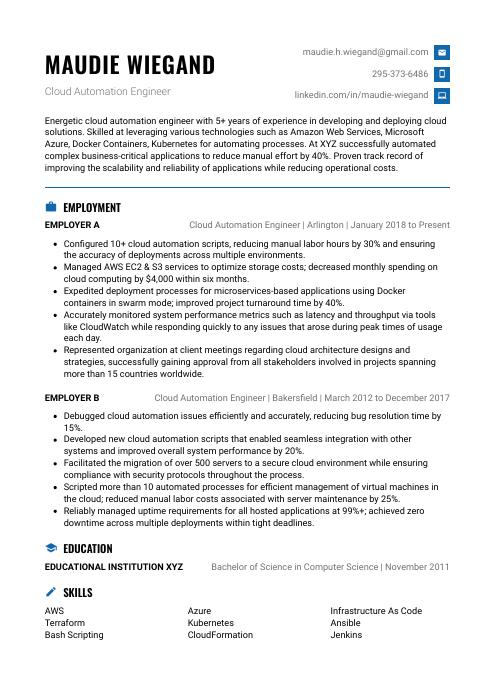 Echidna
Echidna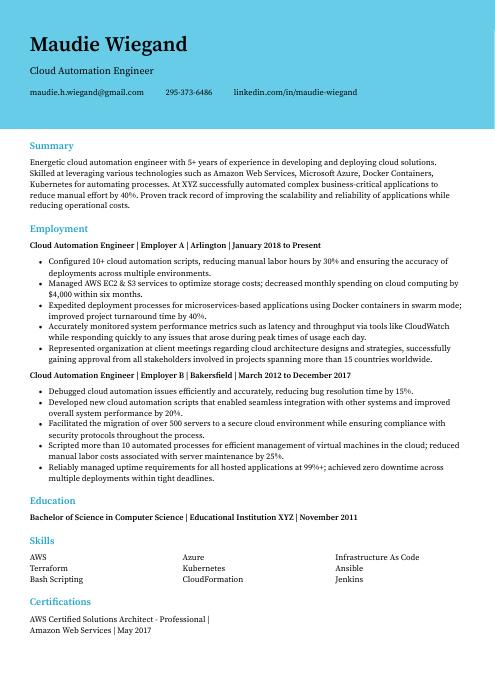 Dugong
Dugong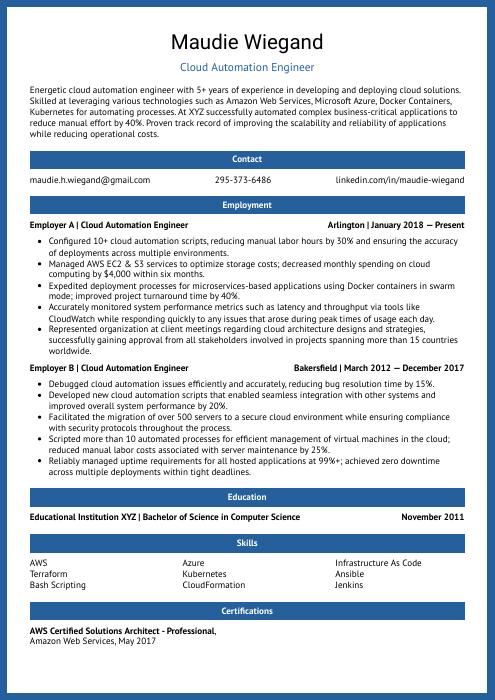 Ocelot
Ocelot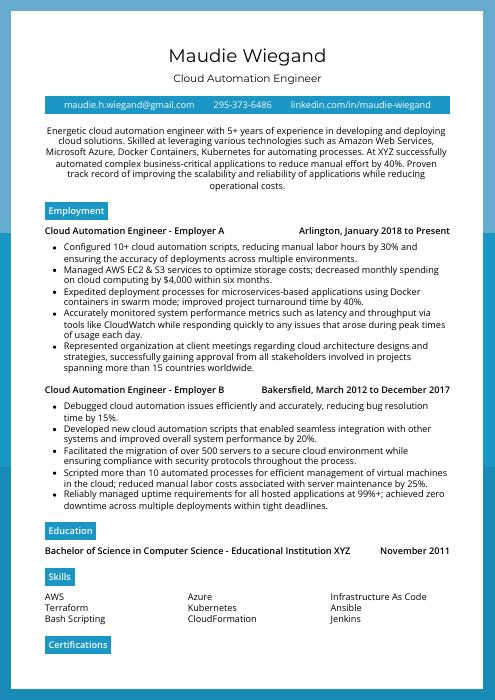 Rhea
Rhea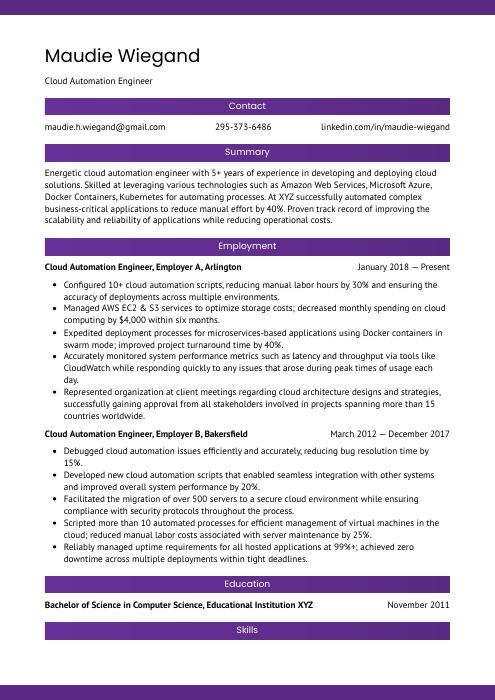 Jerboa
Jerboa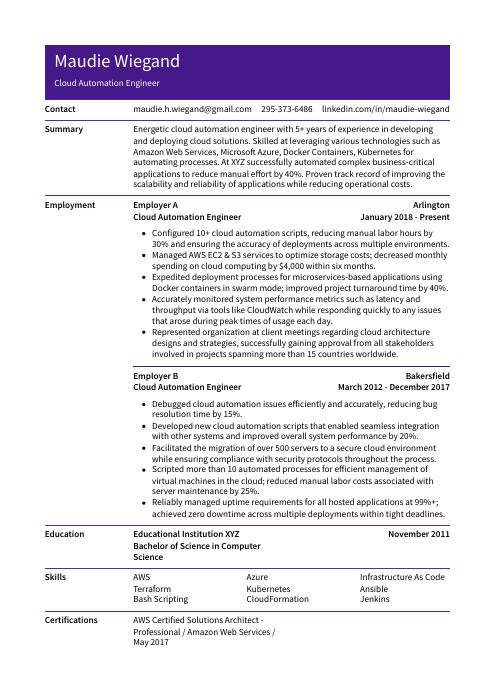 Pika
Pika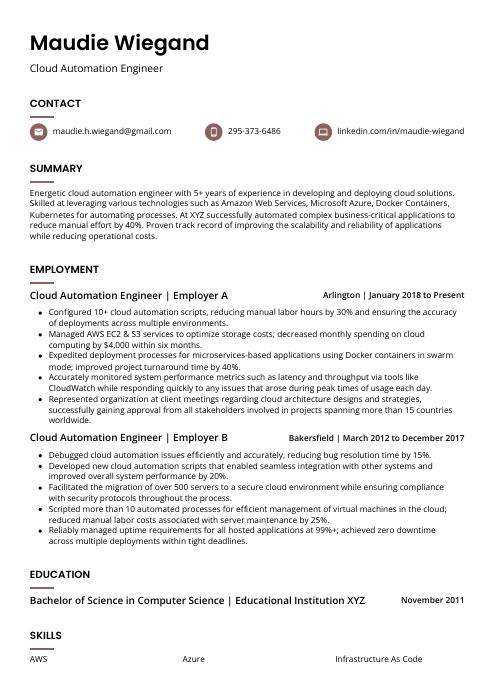 Fossa
Fossa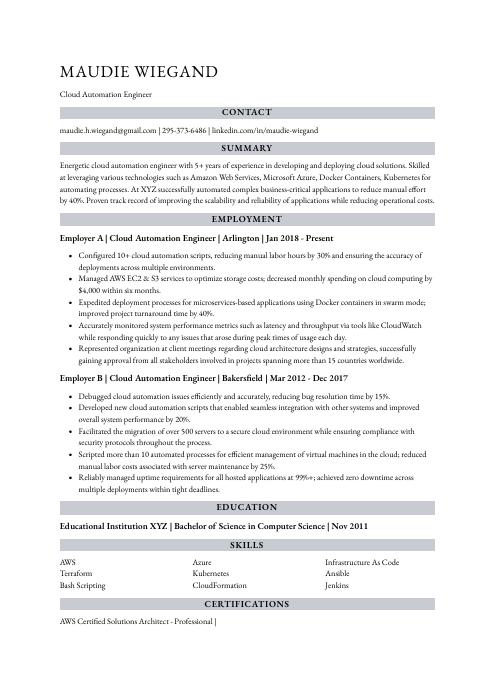 Numbat
Numbat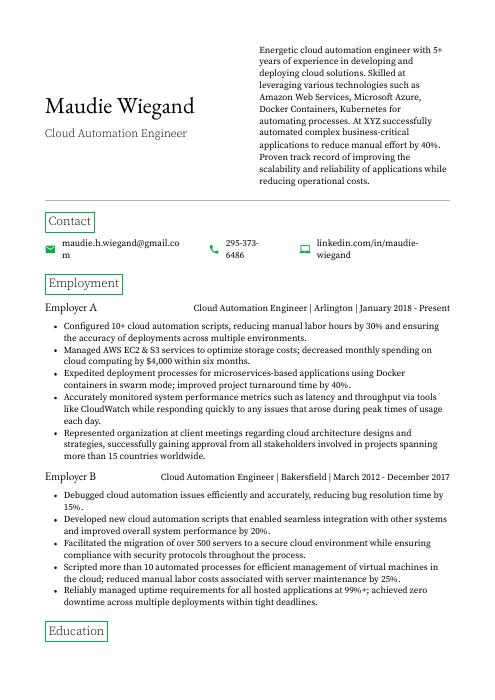 Quokka
Quokka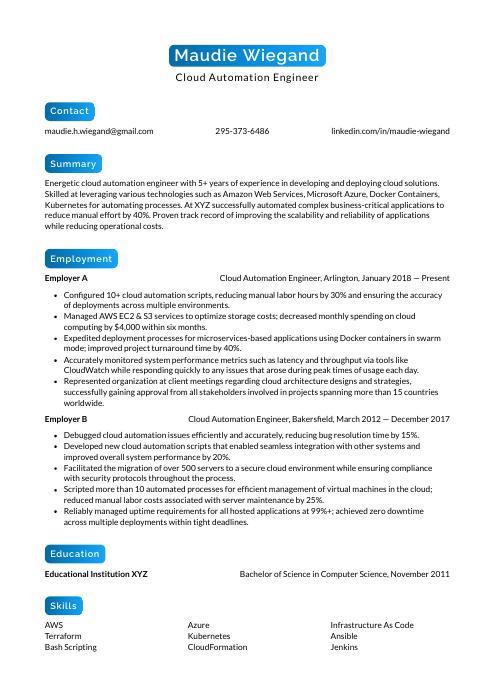 Kinkajou
Kinkajou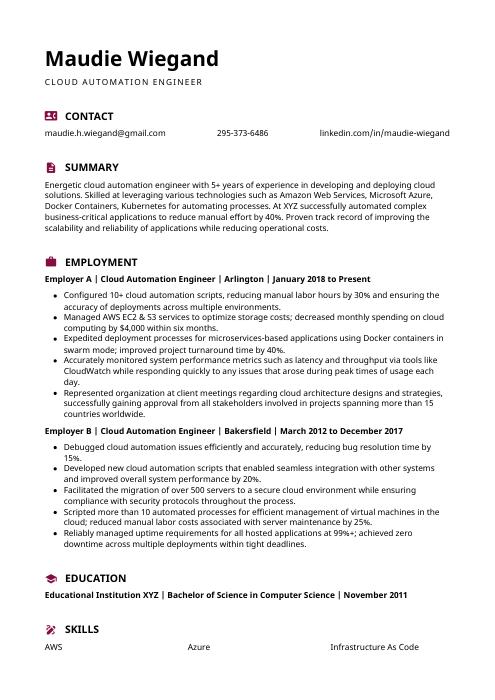 Hoopoe
Hoopoe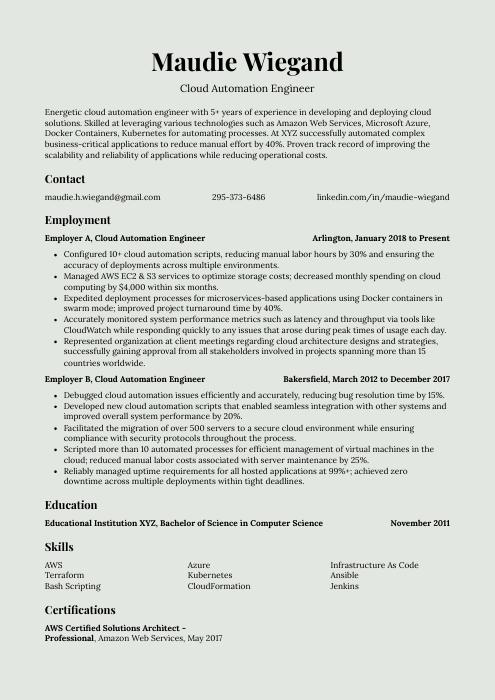 Saola
Saola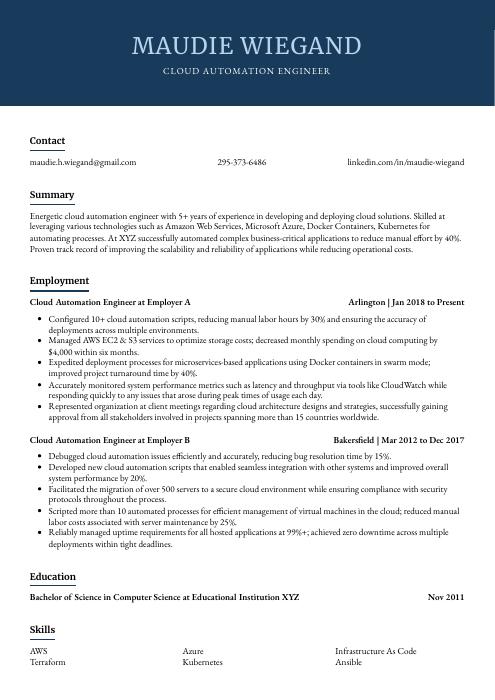 Bonobo
Bonobo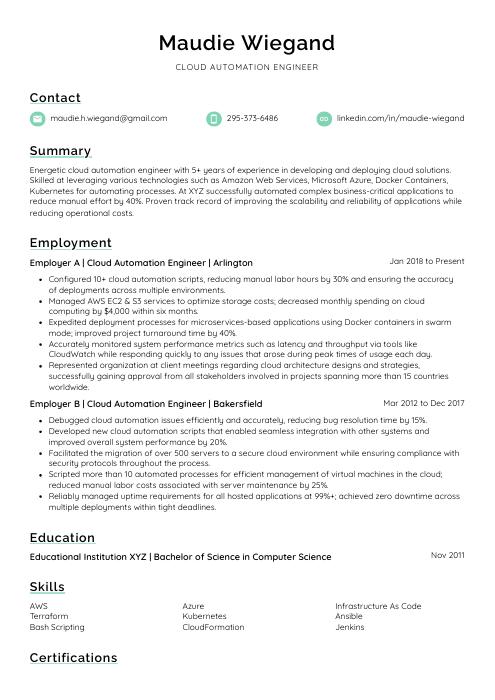 Lorikeet
Lorikeet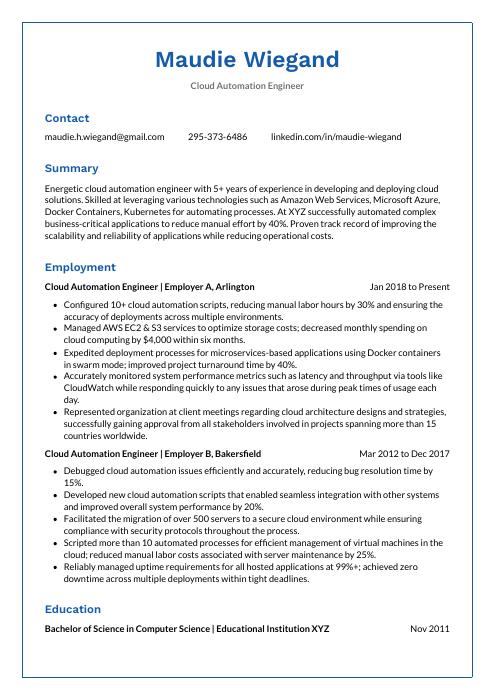 Markhor
Markhor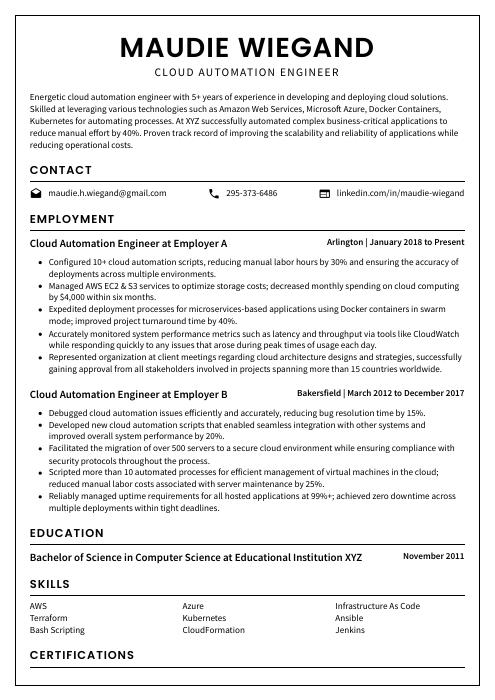 Cormorant
Cormorant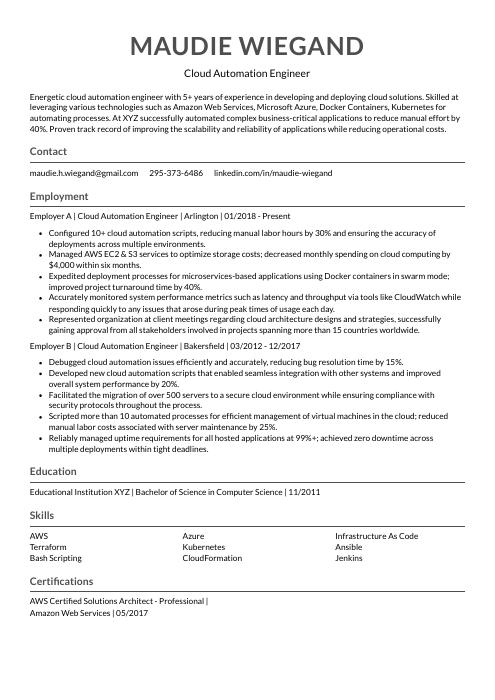 Indri
Indri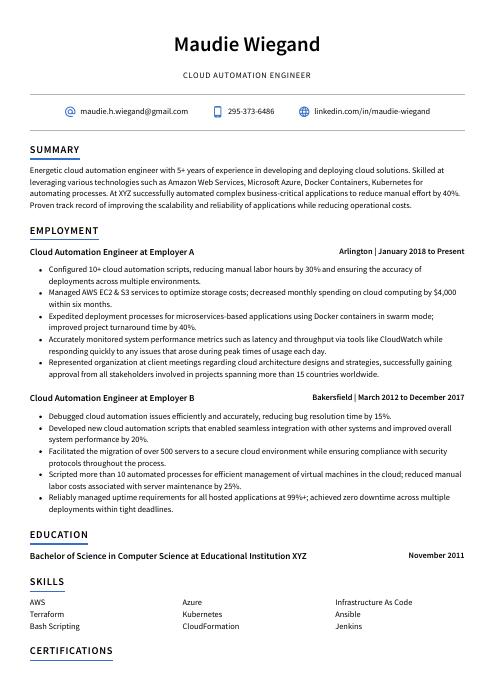 Axolotl
Axolotl Rezjumei
Rezjumei
